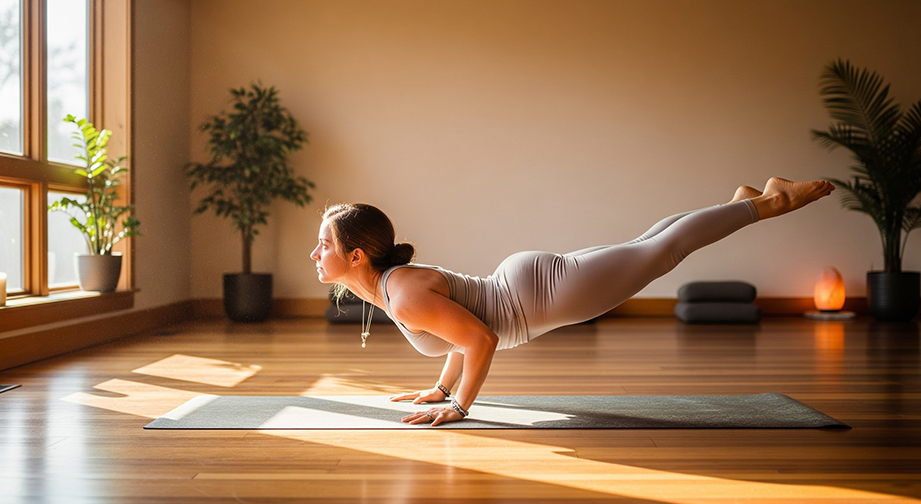Mayurasana (Peacock Pose) – A Balancing Yoga Asana for Strength and Detox
Introduction
Mayurasana, or Peacock Pose, is a classic yoga balancing posture where you lift your entire body by pressing your palms into the ground and balancing on your arms, resembling the elegance of a peacock. The Sanskrit name "Mayura" means "peacock," symbolizing beauty, strength, and balance.
Essence: Energizing and detoxifying.
Ever wondered if you could use just your arms to hold your body off the ground? Mayurasana makes it possible, and is a fantastic way to surprise yourself by building strength and focus—even if you feel a bit stiff or “stuck” after long hours at a desk!
Step-by-Step Guide

- Start in a kneeling position on your mat, knees slightly apart, toes touching behind you.
- Lean forward and place your hands flat on the floor, fingers pointing towards your feet (or angled slightly out for comfort).
- Beginner tip: Keep fingers wide to spread weight.
- Bend your elbows and bring them close together. Press your elbows into your abdomen, around the navel area.
- Extend your legs out straight behind you, keeping them together, toes pointing straight.
- Lean forward as you shift your weight onto your arms.
Inhale: Lengthen your spine and firm your core.
Exhale: Gently lift your feet off the ground.
- Try to keep your body in a straight line—shoulders, hips, and legs aligned.
- Gaze softly at a point in front of you and hold for 3–5 breaths (work up to 10–15 seconds or more as you build strength).
- To release, lower your feet and come back to kneeling. Rest in Child’s Pose.
Modifications for Beginners:
- Keep knees bent and just try to lean forward, lifting one or both feet slightly.
- Use a yoga block under your forehead for support.
To Intensify (Advanced):
- Try Eka Pada Mayurasana (One-legged Peacock)—lift one leg higher.
- Add a slight chin lift for deeper throat opening.
Alignment & Safety Tips
- Alignment cues:
- Keep elbows snug to the abdomen, not splaying out.
- Distribute weight evenly on both palms.
- Core actively draws up and in.
- Legs straight and engaged, inner thighs pressing together.
- Common mistakes to avoid:
- Letting elbows slide off belly.
- Collapsing chest or rounding shoulders.
- Trying to “jump” into the posture (always lean slowly!)
- Precautions:
- Avoid if pregnant or with recent abdominal injury.
- Not recommended for those with wrist, elbow, or shoulder injuries.
- Practice on a soft but stable surface to protect wrists.
Benefits of Mayurasana (Peacock Pose)
- Physical Benefits:
- Strengthens wrists, arms, shoulders, and core.
- Tones digestive organs and boosts metabolism.
- Improves posture and full-body coordination.
- Mental Benefits:
- Builds confidence and perseverance.
- Sharpens concentration and focus.
- Calms the mind through single-pointed awareness.
- Energy / Chakra Connection:
- Stimulates Manipura (Solar Plexus) Chakra—center of willpower and transformation.
Contraindications
- Avoid Mayurasana if you:
- Are pregnant.
- Have hernia, stomach ulcers, or recent abdominal surgery.
- Suffer from carpal tunnel syndrome or shoulder injuries.
- Have high blood pressure or heart conditions.
- Safer alternatives: Cobra Pose (Bhujangasana), Plank Pose, or Dead Bug Pose for core and arm strength without pressure on abdomen or wrists.
Beginner’s Tips & Variations
- Props: Use a yoga block under your forehead or chest for added support.
- Gentle variation: Keep one or both feet on the ground.
- Chair support: Practice arm placement and forward lean sitting on a sturdy chair.
- Advanced variations: One-legged Mayurasana, Full Lotus Legs, or moving into handstand from Peacock pose.
How to Include Mayurasana in a Yoga Flow
- Best suited for: Main practice (after warm-up but before cool down or deep stretching).
- Great poses to pair with:
- Plank Pose (Phalakasana) – warms up arms and core.
- Staff Pose (Dandasana) – lengthens spine and legs.
- Child’s Pose (Balasana) – gentle release afterwards.
Mind-Body Connection
Mayurasana is more than just a physical challenge—it's a mindfulness practice. Move slowly, keeping your breath steady and present. Visualize the sense of inner power (solar energy) rising from your core. The pose activates the Manipura (solar plexus) chakra, the seat of personal power and transformation.
Summary Box
- Asana Name: Mayurasana (Peacock Pose)
- Level: Advanced (with beginner-friendly modifications)
- Focus Areas: Core, arms, wrists, digestion
- Duration: 3–5 breaths (work up to 10–15 seconds)
- Best Time to Practice: Morning (on empty stomach) or early evening
Frequently Asked Questions
Is Mayurasana safe for beginners?
Yes, with modifications such as keeping knees down or using props. Always listen to your body and progress slowly.
What if I have wrist pain in Peacock Pose?
Skip Mayurasana and try wrist-friendly alternatives such as Plank Pose or forearm balances. Strengthen wrists with preparatory exercises, and consult a yoga teacher or therapist if needed.
How can I build up the strength needed?
Practice Plank Pose, Chaturanga, and simple core work. Strengthen wrists and forearms with wrist circles and gentle weight-bearing exercises.
Remember, every yogi’s journey is unique! Enjoy the process of building strength and focus, and be gentle with yourself as you explore Mayurasana.